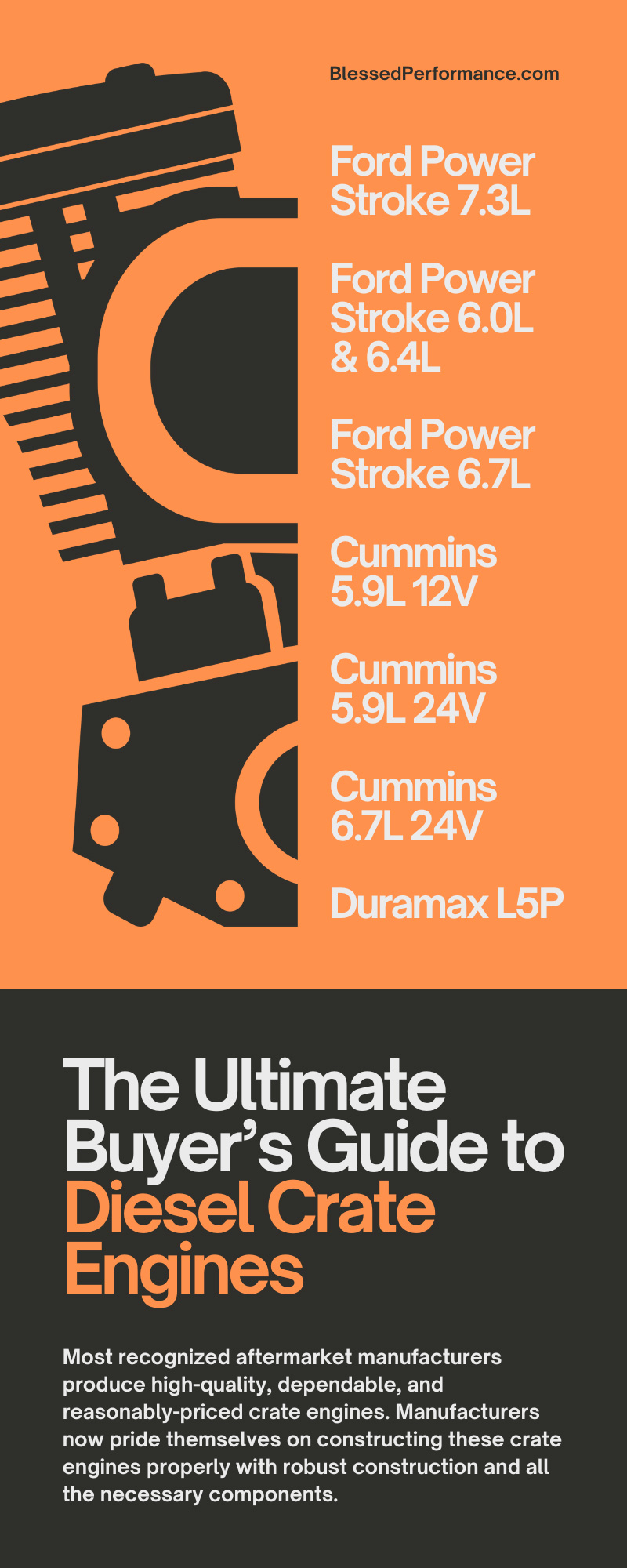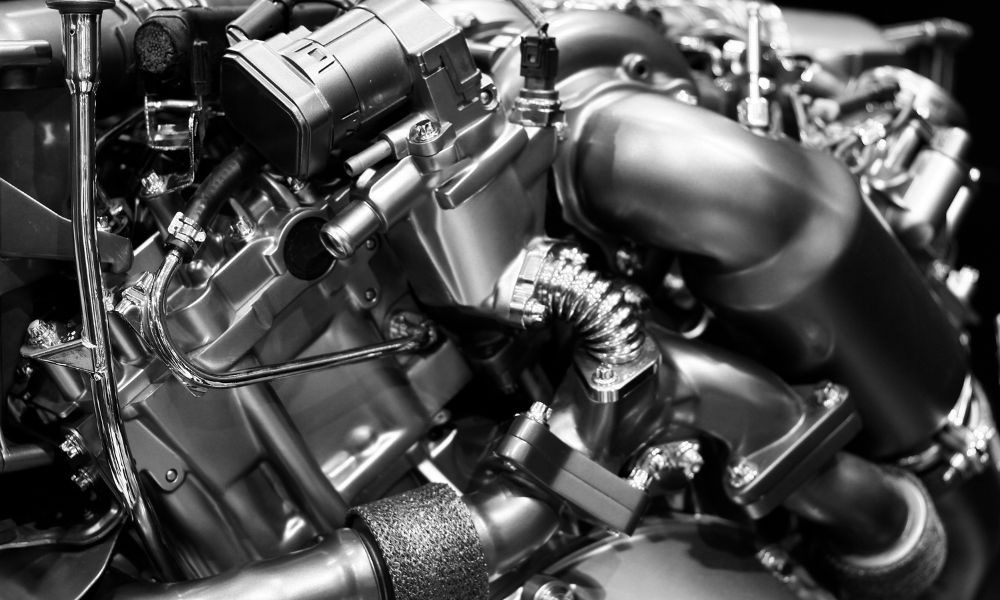The Ultimate Buyer’s Guide to Diesel Crate Engines
10th Feb 2023
Most recognized aftermarket manufacturers produce high-quality, dependable, and reasonably-priced crate engines. Manufacturers now pride themselves on constructing these crate engines properly with robust construction and all the necessary components.
Some naysayers assume that mass production leads to every engine looking and feeling the same. However, all mass production means is there is a level of consistency. Rarely will an error during mass production render hundreds of thousands of engines useless.
There are virtually no disadvantages to using a crate engine. They are generally reasonably priced and constructed by experts who guarantee top-notch quality. We’ll review the various diesel crate engines that Ford, Dodge, and GM offered in this ultimate buyer’s guide to diesel crate engines to help you find the best one for your lean, mean, trucking machine.
Ford Power Stroke 7.3L
The first Ford Power Stroke engine debuted in 1994. They’re noted for their dependability, simplicity, toughness, and extensive parts availability due to high sales quantities. The 7.3L’s direct injection performance and HEUI injection technology guarantee that everyone nearby will hear you coming down the road.
Even though nearly 30 years have passed, the Ford 7.3L is still going strong thanks to its dependability. You can reach upwards of 400,000 with this beast of an engine if properly maintained.
With the pros of the Power Stroke 7.3L, there are cons worth mentioning. There isn’t any factory intercooler, the mechanical lift pump lowers fuel supply pressure, and the additional horsepower and heavy towing capabilities can hinder the automatic E4OD.
Its most evident flaw is the serious camshaft position sensor (CPS) issues. The CPS regulates the pacing of the ignition system by measuring the crankshaft. If the CPS fails, so will your truck’s engine, leaving you with a stalled motor.
Over the nine years of the Power Stroke 7.3L, there are some versions you may want to avoid getting. The original 1994 7.3 engine is durable; however, better ones have been available since they introduced upgrades.
The engines from 2001-2003 had several of the same issues, leaving many Ford enthusiasts dissatisfied. The 2001 7.3L had fuel leaks and was noisier than anticipated, while the following two years continued to have problems with the CPS and EBPV.
Ford Power Stroke 6.0L & 6.4L
Despite stepping down from the beast 7.3L of its prime, the 6.0L Power Stroke Diesel still packs a powerful punch. Ford upgraded the EGR and performance head studs that allowed you to take it to your engine. The 6.0L is also ideal for towing because of its high torque production across a broad range. The most significant selling point for the 6.0L is its fuel efficiency. You can get 16-18 MPG on the road and 19-20 on the highway.
The initial reaction to the 6.0 Power Stroke motor was negative because many drivers were experiencing issues. However, Ford claimed many problems were due to driver error rather than mechanical problems.
The 6.4 is like the 6.0 because of its plug-and-play capabilities, but it hits a roadblock around the 200,000-mile mark. Repairing this engine is costly and not worth the headache when better versions are available.
Ford Power Stroke 6.7L
If there were a crown to award a Power Stroke engine, we would coronate the 6.7L diesel engine. In terms of output, it sets the bar with each version. The recent Ford Super Duty model generates 475 horsepower and a stump-pulling 1,050 pound-feet of torque.
Since its launch in 2011, the 6.7 has also shown to be quite dependable. Yet, there are a few things to keep an eye out for. Turbo failure and EGR issues are widespread on 2011-2014 trucks. Otherwise, it’s difficult to go wrong with this dependable engine.
Cummins 5.9L 12V
The 12V Cummins has minimum electronics, a strong horsepower potential, and is generally simple. Because of the practicality of all its components, you can modify the P-pump for increased flow and improved performance. The P-pump, which has a plunger for each cylinder, enhances the engine’s emissions by reducing the number of particulates in the cylinders. Furthermore, the engine’s fuel injectors can withstand greater fuel pressures.
The downside of a 12V comes from a small dowel pin positioned in the front of the engine. The powerful vibrations of the machine may cause this pin to loosen and release, damaging the front engine cover and the timing gears.
Cummins 5.9L 24V
The 24-valve engine features improved airflow and coolant flow than the 12-valve variant, as well as superior midrange torque and drivability. In addition, the engine has a reusable gasket for the one-piece valve cover, which is an upgrade over the 12V’s six distinct covers.
The rotary injection pump regulates fuel flow and injection time with the truck’s engine management unit. In addition, the 24V incorporates an electronic fuel lift pump to maintain constant fuel pressure.
There are a few drawbacks of the 5.9 24V engine, with one being thinner walls on the cast iron engine block. These thin walls were prone to break or freeze, culminating in coolant leakage. Furthermore, although the fuel pump is an upgrade, it’s costly to repair if it malfunctions.
Cummins 6.7L 24V
There isn’t much difference between the 5.9L and 6.7L 24V Cummins, considering that nearly half of the components carried over and the common-rail injection is virtually identical. But overall, this Cummins engine is the better choice. The 6.7L’s towing capabilities are more robust than its predecessor because of the variable geometric motor. Moreover, the 6.7L is kinder to you at the pump, saving you around two or three miles to the gallon compared to the 5.9. Thus, the 6.7L 24V Cummins takes the cake.
Duramax L5P
Duramax has been going strong since the mid-1980s, so there have been several versions and attempted upgrades to the motor. Though, the one you want to have your sights set on is the Duramax L5P engine.
The L5P is the most recent and best version of the Duramax. It is far more resilient than earlier Duramax versions and has 445 HP and 910 lb-ft of torque. In Chevy Silverado pickup trucks, the L5P replaced the LML.
Many consider this addition to the Duramax family as the most reliable diesel engine on the market, particularly when coupled with an Allison transmission. Other positives of the Duramax L5P are its upgraded air intake system, single-cooler exhaust gas recirculation system, and cylinder head casting for improved airflow and head strength.
The ultimate buyer’s guide to diesel crate engines should provide the necessary insight into what you should look for in your truck. Luckily, there are variations of each diesel crate engine that you can depend on in the Power Stroke 6.7L, Cummings 6.7L 24V, and the Duramax L5P.
Blessed Performance guarantees a well-constructed, powerful engine that can last hundreds of thousands of miles. If you need more assistance or clarification on what motor suits your needs, our team will be happy to help in any way we can!


